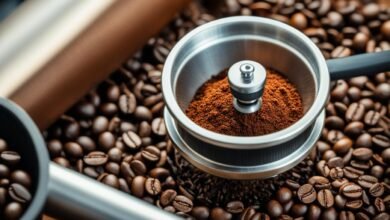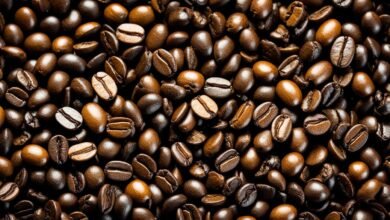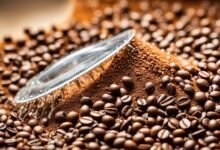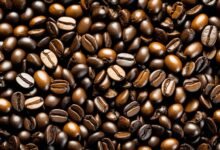Comparing Different Coffee Brewing Methods: Which is Right for You?
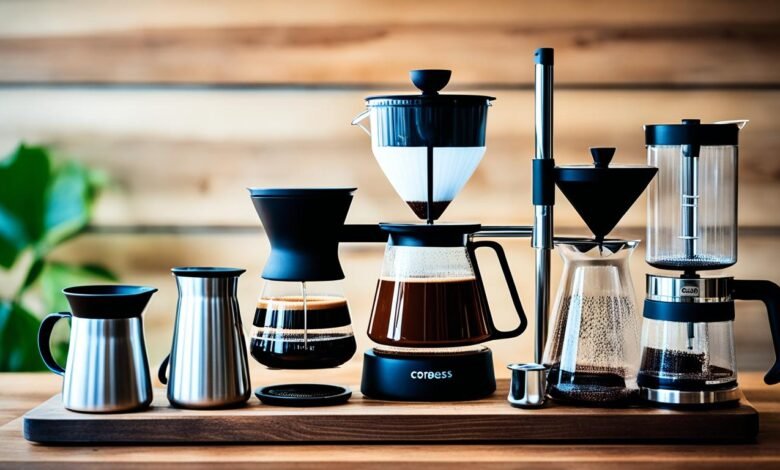
As a self-proclaimed coffee enthusiast, I’ve been on a never-ending journey to find the perfect brewing method that consistently delivers the rich, aromatic, and flavorful cup of joe I crave each morning. From the velvety smoothness of a French press to the clean, bright notes of a pour-over, each brewing technique offers a unique experience that can elevate the taste of your coffee. In this comprehensive guide, we’ll dive into the pros and cons of popular coffee brewing methods, including French press, AeroPress, pour-over (Chemex, Hario V60, Kalita Wave), Moka pot, drip coffee maker, siphon brewing, and cold brew, to help you determine which is the right fit for your personal coffee preferences and brewing style.
Key Takeaways
- Explore a variety of coffee brewing methods to find your perfect cup
- Understand the unique characteristics and benefits of each brewing technique
- Discover the brewing methods that best suit your personal coffee preferences
- Learn the pros and cons of popular coffee brewing methods
- Determine the brewing method that aligns with your desired flavor profile and brewing experience
Introduction to Coffee Brewing Methods
Brewing the perfect cup of coffee is an art that requires an understanding of the various brewing methods and the factors that influence the final flavor. From the classic French press to the modern AeroPress, each coffee brewing technique has its own unique characteristics that can impact the coffee extraction and ultimately the taste profile.
Factors Affecting Coffee Extraction and Flavor
The type of equipment or device used to brew coffee has a significant impact on the taste and flavor of the final cup. Factors like the shape and size of the brewer, the batch size, and the specific brewing technique all contribute to the coffee’s extraction and overall flavor profile. Understanding how these variables interact and the unique characteristics of different brewing methods will help you brew better coffee at home.
Coffee extraction is the process by which the soluble compounds in the coffee grounds are dissolved into the water, producing the desired flavor. Factors such as water temperature, contact time, and the grind size of the coffee beans can all influence the extraction process and the final taste of the coffee.
| Brewing Method | Coffee Dose (grams) | Brewing Time (minutes) | Batch Size |
|---|---|---|---|
| French Press | 14-17 | 4 | Up to 8 cups |
| AeroPress | 17 | 1-2 | 1-2 cups |
| Chemex | 42 | 4 | Multiple cups |
| Moka Pot | 17-22 | 5 | Espresso-style shot |
| Siphon | 40 | 6 | Multiple cups |
By understanding the factors that affect coffee extraction and flavor, you can make informed choices about the brewing method that best suits your preferences and the type of coffee you’re enjoying.
French Press
The French press is a beloved and time-honored coffee brewing method, renowned for its ability to produce a full-bodied, rich, and creamy cup of coffee. This classic technique is a great choice for medium to dark roast coffee blends, highlighting the bold, chocolaty, and roasty flavors that many coffee enthusiasts crave.
Pros and Cons of the French Press Method
The French press is an easy-to-use, beginner-friendly method that can brew 2-3 cups of full-bodied coffee at a time. The mesh filter allows more oils and sediment to pass through, contributing to the coffee’s textured mouthfeel. However, the full immersion brewing is not as efficient at extracting all the flavors, and the brew can take over 5 minutes to complete.
Brewing Guide for French Press Coffee
- Start with fresh-roasted French press coffee beans, grinding them to a coarse, breadcrumb-like consistency.
- Use a ratio of 56g (8 tablespoons) of coffee for an 8-cup French press, and heat the water to around 205°F (96°C).
- Pour the hot water over the grounds and stir gently to ensure even saturation.
- Allow the coffee to steep for 4 minutes, breaking the crust that forms on the surface at the 1-minute mark.
- Slowly press down the plunger to separate the grounds from the rich, creamy coffee.
- Pour and enjoy your full-bodied coffee immediately, as the French press method can result in a more sediment-heavy brew.
After brewing, the French press cleaning process is straightforward: add a little water to the grounds, swirl, and dispose of the contents in the trash or compost bin.
| Feature | French Press |
|---|---|
| Brew Time | 4 minutes |
| Grind Size | Coarse, breadcrumb-like |
| Coffee-to-Water Ratio | 56g (8 tbsp) coffee for 8 cups |
| Water Temperature | 205°F (96°C) |
| Cleaning | Add water, swirl, and dispose |
The French press has maintained its classic, well-engineered design since its invention in 1929, and remains a beloved choice for coffee enthusiasts who appreciate a full-bodied, rich, and creamy brew. With its straightforward brewing process and ability to deliver multiple cups of delicious coffee, the French press is a versatile and user-friendly option for coffee lovers of all skill levels.
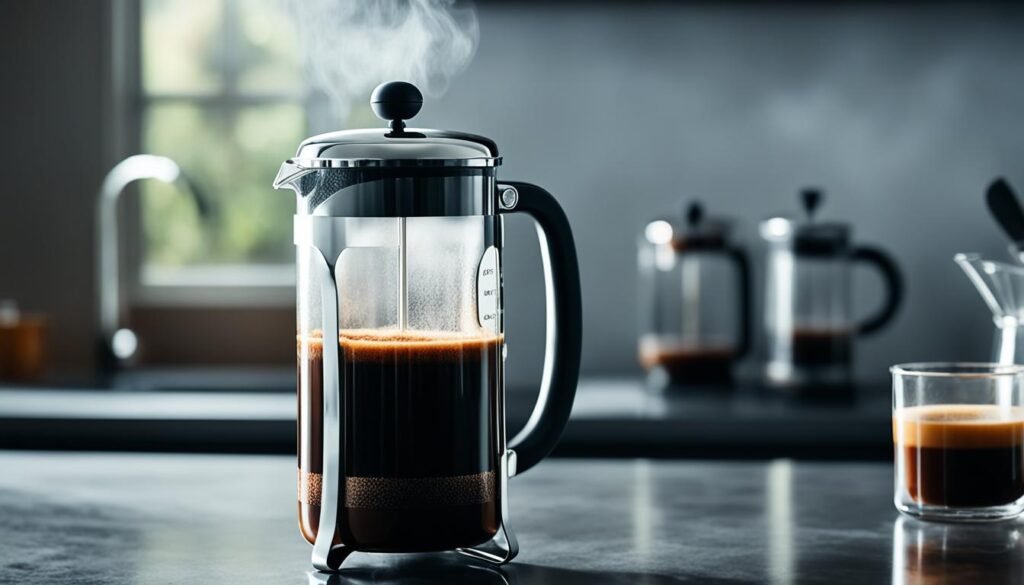
AeroPress
The AeroPress is a versatile coffee brewing method that can produce a clean, bright, and flavorful cup of coffee. This unique brewer combines the full immersion of a French press with the percolation of a pour-over, and the introduction of pressure creates a customizable and efficient brewing process.
Invented in 2005 by Alan Adler at Stanford University, the AeroPress has become a popular choice among coffee enthusiasts globally. It’s an efficient, easy-to-pack, and virtually indestructible brewer, making it perfect for both home use and travel. However, it’s not the best option if you’re looking to brew more than 6-10 ounces of coffee at a time.
The AeroPress brewing method typically requires 17g of coffee or approximately 2 1/2 tablespoons, and the water should be heated to around 205°F. This process yields around 7 to 8 ounces of bold and versatile coffee. The suggested coffee-to-water ratio for AeroPress recipes is often around 1:12 to 1:16, much stronger than the standard 1:16 ratio for other brewing methods.
The clean and bright flavor profile of AeroPress coffee is achieved through the unique brewing process. Grind particle size, brew time, water temperature, and turbulence are all significant variables that can be adjusted to create a customized cup. With its versatility and ease of use, the AeroPress is an excellent choice for coffee enthusiasts looking to experiment and discover their perfect cup of AeroPress coffee.
“The AeroPress is a game-changer for coffee lovers who want a quick, consistent, and high-quality brew at home or on the go.”
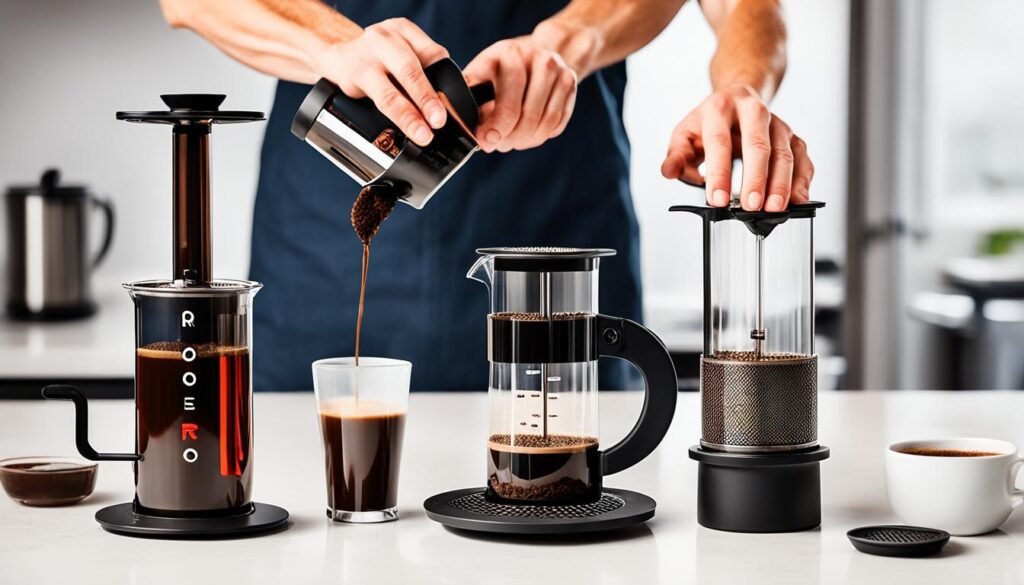
Pour Over Methods
For coffee enthusiasts seeking a clean, bright, and crisp cup that showcases the nuanced flavors of light to medium roast single-origin beans, pour-over coffee methods are a popular choice. These artisanal brewing techniques, such as the Chemex, Hario V60, and Kalita Wave, produce a lively and flavorful brew that allows the natural fruity and clean notes of the coffee to shine.
The key to these pour-over methods is the use of paper filters, which help remove oils and sediment, resulting in a smooth, delicate texture. While mastering the pour-over technique may take some practice, the elegant design and exceptional flavor profile of these brewers make them a favorite among coffee enthusiasts who appreciate the bright and crisp qualities of a well-executed pour-over coffee.
Chemex
Invented in 1941 by Dr. Peter Schlumbohm, the Chemex pour-over system is renowned for its distinctive hourglass shape and thick, proprietary paper filters. This method can take up to five minutes longer than other pour-over techniques, but the result is a clean, bright, and crisp coffee that beautifully showcases the nuanced flavors of light roast and medium roast single-origin beans.
Hario V60
The Hario V60, with its conical shape and 60-degree angle, is a popular pour-over brewer among coffee enthusiasts. This method requires precise grinding and pouring techniques to ensure even saturation and extraction, but the result is a bright, lively, and flavorful coffee that highlights the fruity notes of the beans.
Kalita Wave
Invented in Japan in the early 2000s, the Kalita Wave pour-over system features a unique flat-bottom design that ensures more surface area contact between the water and the coffee grounds. This, in turn, leads to a clean, balanced, and complex flavor profile that is perfect for showcasing the nuances of light roast and medium roast single-origin coffee.

“The pour-over ritual is essential for achieving a delicate and complex taste in coffee.”
– Blue Bottle, a leading specialty coffee company
Coffee Brewing Methods
The art of brewing coffee is a fascinating interplay between various techniques, each with its unique impact on the final flavor profile. From the immersion methods of the French Press to the precision of pour-over techniques, understanding how these coffee brewing methods influence coffee extraction and coffee flavor is the key to crafting your perfect cup at home.
The French Press, for instance, is known for producing a rich, full-bodied cup due to its longer contact time with the grounds. On the other hand, the Aeropress utilizes pressure to create a smooth, concentrated brew. Pour-over methods like the Chemex and Hario V60 allow for precise control over extraction, yielding clean, nuanced flavors.
| Brewing Method | Extraction Time | Flavor Profile |
|---|---|---|
| French Press | 2-4 minutes | Rich, full-bodied |
| Aeropress | 20-30 seconds | Smooth, concentrated |
| Chemex | 4-6 minutes | Clean, nuanced |
| Hario V60 | 2-4 minutes | Bright, complex |
| Moka Pot | 3-5 minutes | Intense, espresso-like |
| Cold Brew | 12-24 hours | Smooth, low-acid |
Regardless of the method, maintaining the right water temperature (195-205°F) and coffee-to-water ratio (1-2 tablespoons per 6 ounces) is crucial for optimal coffee extraction and flavor. Experiment with different techniques, beans, and grind sizes to find your perfect brew.
Moka Pot
If you’re a coffee enthusiast seeking a robust, espresso-like brew in the comfort of your own kitchen, the Moka pot is a must-try. This stovetop percolator, invented in 1933 by Italian engineer Alfonso Bialetti, has become a beloved icon in homes and cafes around the world for its ability to produce a concentrated, full-bodied coffee with a distinctly rich and satisfying flavor.
Brewing Guide for Moka Pot Coffee
Mastering the Moka pot brewing method takes a bit of practice, but the rewards are well worth it. Here’s a step-by-step guide to help you brew the perfect cup of Moka pot coffee:
- Start with freshly ground coffee beans, using a consistent fine to medium-fine grind size. The recommended amount is 15-17 grams of coffee per 6-cup Moka pot.
- Fill the bottom chamber with water, being careful not to exceed the safety valve. The water should be around 99 degrees Celsius (210 degrees Fahrenheit).
- Gently tamp the ground coffee into the filter basket, then screw the top chamber onto the bottom chamber.
- Place the Moka pot on the stove over medium heat. As the water heats, you’ll hear a characteristic gurgling sound, which indicates the brewing process is underway.
- Once the coffee has finished brewing, which typically takes 1-3 minutes, remove the Moka pot from the heat and run the bottom chamber under cold water to stop the brewing process and prevent bitterness.
The resulting Moka pot coffee will be significantly more concentrated and intense than regular drip coffee, with a rich, full-bodied texture reminiscent of espresso. It’s a perfect base for espresso-based drinks like cappuccinos, lattes, and americanos.
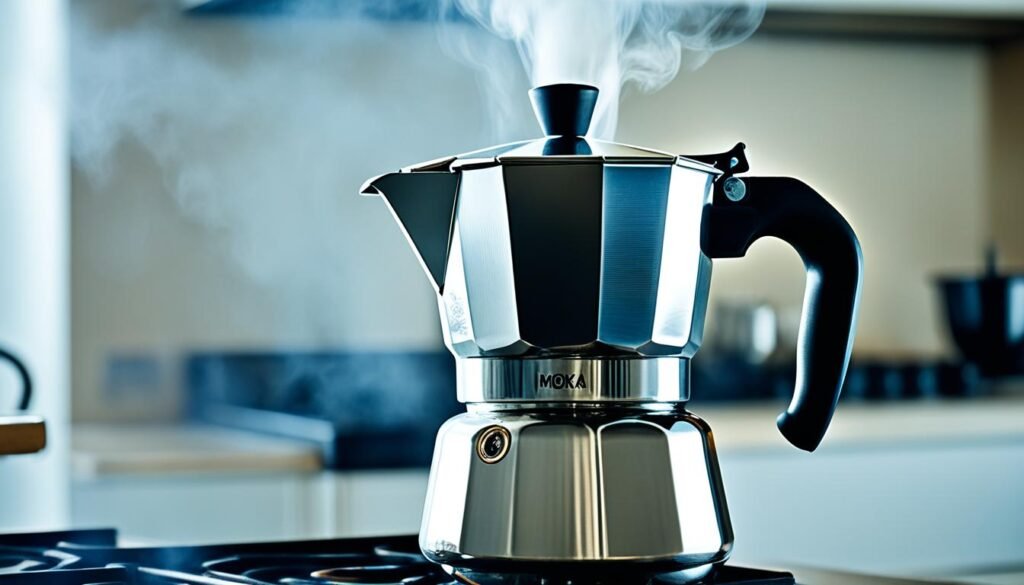
While the Moka pot may not produce true espresso, which requires 8-10 bars of pressure, it creates a unique and satisfying coffee experience that is beloved by coffee enthusiasts around the world. With a little practice, you can brew a delightful concentrated coffee right at home.
Drip Coffee Maker
Drip coffee makers have long been a staple in American kitchens, offering a convenient way to brew multiple cups of balanced, aromatic coffee at once. The invention of the first electric drip coffee maker, the Wigomat, in 1954 marked a significant milestone in the history of this popular brewing method. Today, drip coffee machines remain a beloved choice for their ability to consistently produce a flavorful cup of coffee with a rounded body and acidity.
When selecting a drip coffee maker, it’s essential to look for a high-quality, SCA-certified brewer that can maintain the optimal brewing temperature throughout the process. Many cheaper drip machines fail to reach the ideal range of 195.8°F to 204.8°F, as recommended by the Specialty Coffee Association of America (SCAA), leading to subpar extraction and a sour-tasting brew, especially with lighter roasts.
Investing in a quality drip coffee maker can make all the difference in your daily balanced coffee routine. Automatic drip machines certified by the SCAA, such as Bonavita or Technivorm Moccamaster, are known for their ability to deliver consistent water temperature during brewing, ensuring a convenient, flavorful cup every time.
For coffee enthusiasts who prefer a more hands-on approach, manual pour-over drip methods have also gained popularity in recent years. These methods offer greater control over the brewing process and allow for customization to suit individual preferences, often resulting in a more robust and flavorful cup of coffee compared to traditional automatic drip coffee makers.
Ultimately, the choice between a manual pour-over or an automatic drip coffee maker comes down to personal preference and brewing needs. Whether you’re looking for a convenient way to brew coffee for a crowd or seeking a more balanced, handcrafted experience, there’s a drip coffee solution that can cater to your unique coffee-drinking preferences.
Siphon Brewing
Siphon brewing, often referred to as vacuum pot or siphon coffee, is a mesmerizing and theatrical method that produces a delicate, tea-like cup of coffee. This all-glass contraption utilizes a combination of immersion, vacuum pressure, and heat to extract the coffee, resulting in a brew that is often described as elegant and complex, with exceptional clarity of flavor.
While the siphon brew method can be persnickety and requires some technical skill, the final product is well worth the effort for coffee enthusiasts seeking a unique and captivating experience. The brewing process, which resembles a chemistry lab setup, involves a Bunsen burner as a heat source, glass flasks, tubes, and beakers, creating a visually striking performance.
To brew siphon coffee, the recommended coffee-to-water ratio is 1:15, with the ideal water temperature being 206°F. A fine grind setting, between 3 and 4 on a Fellow Ode grinder, is preferred for siphon coffee beans. The optimal brew time is around 60 seconds, with the total brew time typically lasting about 3 minutes.
Despite its theatrical appeal, siphon brewing remains a niche method, with only a small percentage of coffee drinkers using it as their primary brewing device. However, for those willing to invest in the equipment, which can cost upwards of $200 for a Hario Technica Glass Syphon Coffee Maker ($92 reduced to $81 on Amazon) and a Bluefire Butane Mini Burner ($40 on Amazon), the rewards of a delicate, tea-like siphon coffee are undeniable.
“The siphon brew method produces a cup of coffee that is truly a work of art, with a unique and captivating flavor profile that sets it apart from other brewing methods.”
For those seeking to elevate their coffee experience and embrace the theatrical aspects of brewing, the siphon method is a must-try. The investment in equipment and the mastery of the technique may be daunting, but the resulting delicate coffee and tea-like coffee is a testament to the art of siphon coffee brewing.
Cold Brew
If you’re a coffee enthusiast seeking a refreshing and smooth brew, look no further than cold brew coffee. This brewing method, which involves steeping coffee grounds in room-temperature water for an extended period, results in a distinctly crisp, silky, and less acidic beverage perfect for hot summer days.
The cold brew process, also known as immersion brewing, allows the coffee to extract over 8-12 hours, producing a concentrated liquid that can be diluted with water or milk to create a refreshing iced coffee. Depending on the coffee beans used, cold brew can showcase a range of flavors, from tart and fruity to rich and chocolaty.
For those who prefer a brighter, more vibrant iced coffee, the Japanese Iced Coffee method might be the way to go. This technique involves brewing hot coffee directly over ice, resulting in a crisp and refreshing cup that highlights the coffee’s natural acidity and nuanced flavors.
Another intriguing cold brew method is the Ice Drip Brewing, or Kyoto-style, which uses a slow drip process over 24 hours or more. This meticulous technique produces a clean, body-rich coffee with exceptional clarity and a focus on floral or fruity notes.
- Immersion brewing in cold brew coffee involves combining cold water and ground coffee and letting it sit for a few hours.
- Cold brew with the immersion method is known for being balanced with low acidity, resulting in a mellow coffee with minimal effort.
- Japanese Iced Coffee is a method that involves brewing hot coffee directly onto ice, resulting in a bright, crisp, and refreshing taste with extracted acids.
- Ice Drip Brewing, also known as Kyoto ice drip or Dutch ice drip, is a slow drip technique where cold water drips slowly onto coffee for over 24 hours.
With the rise in popularity of cold brew, coffee enthusiasts now have a wealth of techniques and flavors to explore, allowing them to create personalized cold coffee experiences that suit their individual preferences. Whether you prefer a smooth, low-acid brew or a bright, vibrant iced coffee, the world of cold brew offers a refreshing and versatile way to enjoy your daily cup of joe.
Espresso Machines
For coffee enthusiasts, brewing espresso at home can be a game-changer, allowing you to craft your own cafe-style drinks with precision and control. Espresso machines are designed to produce a concentrated, complex beverage that can be enjoyed on its own or combined with milk to create a variety of espresso-based drinks. While setting up a home espresso machine requires a larger investment and steeper learning curve compared to other brewing methods, the ability to customize your setup and perfect your technique makes it a rewarding pursuit for dedicated coffee lovers.
Exploring Home Espresso Machines
Brands like Rocket offer high-quality home espresso machines that can help you achieve professional-level results. These machines are designed to replicate the precise pressure, temperature, and water flow found in commercial espresso machines, allowing you to craft rich, flavorful espresso shots at home. With the right equipment and a bit of practice, you can master the art of pulling the perfect shot and creating a variety of espresso-based drinks and cafe-style drinks.
| Espresso Brewing Attributes | Typical Values |
|---|---|
| Espresso Shot Size | 1 ounce |
| Brew Time | 20-30 seconds |
| Water Temperature | 195°F to 205°F |
| Pressure | 9-15 bars |
| Coffee Dose | 7-9 grams |
While home espresso machines can be a significant investment, the ability to craft your own custom drinks at home can be a rewarding experience for coffee enthusiasts. With the right machine and a bit of practice, you can elevate your daily coffee routine and enjoy cafe-quality espresso-based drinks in the comfort of your own kitchen.
Conclusion
Choosing the right coffee brewing method ultimately comes down to your personal preferences and the characteristics you’re looking for in your cup of coffee. Whether you prefer the full-bodied richness of a French press, the clean and bright flavors of a pour-over, or the versatility of an AeroPress, understanding the unique attributes of each brewing technique can help you find the method that best suits your taste and brewing style.
By exploring the pros and cons of these different coffee coffee brewing methods, you’ll be well on your way to brewing your perfect cup at home. From the traditional Ibrik method to the innovative cold brew process, the world of coffee brewing offers a wide range of options to satisfy even the most discerning coffee enthusiasts. Experiment with different techniques and discover the perfect cup of coffee that caters to your personal preferences.
Ultimately, the joy of coffee brewing lies in the journey of discovering your own unique coffee ritual. So, grab your favorite mug, fire up your preferred coffee maker, and embark on a flavorful adventure that will leave you energized and inspired.
